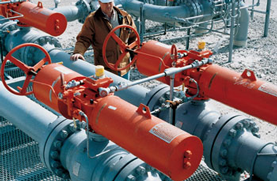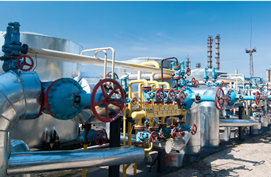Valve Automation is recognized worldwide for the reliability of its
actuators under the most demanding conditions. The gas/hydraulic
products epitomize the quality and performance required for controlling
high pressure natural gas pipelines in remote locations and under severe
climatic conditions.Bettis gas/hydraulic actuators are used to automate
valves located on gas transmission pipelines, often travelling hundreds
of miles through remote areas, where there are no low pressure
instrument air or high pressure hydraulic supply lines available.The
gas/hydraulic actuators operate using pressurized gas from the pipeline
as its power source, requiring reliability and safety features built
into the valve operator system. Since the line gas is a potential
hazard, Bettis actuators use a clean, nonexplosive hydraulic fluid as an
oil barrier rather than direct line gas.
Some of the salient features include High torques and thrusts. Rotary
quarter-turn models have torques upto 6,000,000 lb. in (678,000 Nm)and
linear models with thrusts up to 650,000 lbs(2,891,200 N). They are most
adaptable for all types of gas compositions including sour(NACE)and wet
gas. Standard operating temperature is -50°F to 150°F (-46°C to +
66°C)and Standard operating pressure is upto 1,440 PSIG.
-
 Hot newWhat is the difference between a rotary and a linear actuator?2018-02-11
Hot newWhat is the difference between a rotary and a linear actuator?2018-02-11Actuators can be classified into two types based on their motion. Two primary actuator types are rotary, andlinear. An example of a rotar…
Learn More -
 Hot newWhy the Trunion mounted ball valve scores over floating ball valves.2017-08-29
Hot newWhy the Trunion mounted ball valve scores over floating ball valves.2017-08-29Floating ball valves are widely used across most manufacturing plants in the Oil and Gas, Petrochemicalsand Refining industry. They are c…
Learn More -
 Hot newHow to select the right valve for your application?2017-07-28
Hot newHow to select the right valve for your application?2017-07-28This is a topic of debate very often between EPC buyers, design engineers and End users in the downstream manufacturing plants. many a ti…
Learn More
Bettis gas/hydraulic actuators automate pipeline valves
2015-09-20
